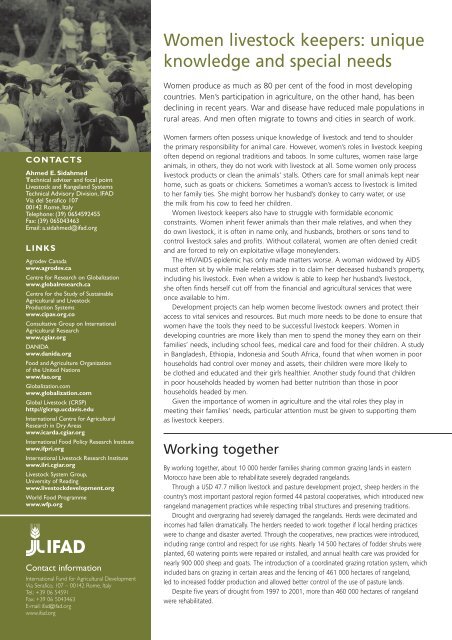Livestock services factsheet - IFAD
Livestock services factsheet - IFAD
Livestock services factsheet - IFAD
Create successful ePaper yourself
Turn your PDF publications into a flip-book with our unique Google optimized e-Paper software.
Women livestock keepers: unique<br />
knowledge and special needs<br />
Women produce as much as 80 per cent of the food in most developing<br />
countries. Men’s participation in agriculture, on the other hand, has been<br />
declining in recent years. War and disease have reduced male populations in<br />
rural areas. And men often migrate to towns and cities in search of work.<br />
CONTACTS<br />
Ahmed E. Sidahmed<br />
Technical adviser and focal point<br />
<strong>Livestock</strong> and Rangeland Systems<br />
Technical Advisory Division, <strong>IFAD</strong><br />
Via del Serafico 107<br />
00142 Rome, Italy<br />
Telephone: (39) 0654592455<br />
Fax: (39) 065043463<br />
Email: a.sidahmed@ifad.org<br />
LINKS<br />
Agrodev Canada<br />
www.agrodev.ca<br />
Centre for Research on Globalization<br />
www.globalresearch.ca<br />
Centre for the Study of Sustainable<br />
Agricultural and <strong>Livestock</strong><br />
Production Systems<br />
www.cipav.org.co<br />
Consultative Group on International<br />
Agricultural Research<br />
www.cgiar.org<br />
DANIDA<br />
www.danida.org<br />
Food and Agriculture Organization<br />
of the United Nations<br />
www.fao.org<br />
Globalization.com<br />
www.globalization.com<br />
Global <strong>Livestock</strong> (CRSP)<br />
http://glcrsp.ucdavis.edu<br />
International Centre for Agricultural<br />
Research in Dry Areas<br />
www.icarda.cgiar.org<br />
International Food Policy Research Institute<br />
www.ifpri.org<br />
International <strong>Livestock</strong> Research Institute<br />
www.ilri.cgiar.org<br />
<strong>Livestock</strong> System Group,<br />
University of Reading<br />
www.livestockdevelopment.org<br />
World Food Programme<br />
www.wfp.org<br />
Contact information<br />
International Fund for Agricultural Development<br />
Via Serafico, 107 – 00142 Rome, Italy<br />
Tel.: +39 06 54591<br />
Fax: +39 06 5043463<br />
E-mail: ifad@ifad.org<br />
www.ifad.org<br />
Women farmers often possess unique knowledge of livestock and tend to shoulder<br />
the primary responsibility for animal care. However, women’s roles in livestock keeping<br />
often depend on regional traditions and taboos. In some cultures, women raise large<br />
animals, in others, they do not work with livestock at all. Some women only process<br />
livestock products or clean the animals’ stalls. Others care for small animals kept near<br />
home, such as goats or chickens. Sometimes a woman’s access to livestock is limited<br />
to her family ties. She might borrow her husband’s donkey to carry water, or use<br />
the milk from his cow to feed her children.<br />
Women livestock keepers also have to struggle with formidable economic<br />
constraints. Women inherit fewer animals than their male relatives, and when they<br />
do own livestock, it is often in name only, and husbands, brothers or sons tend to<br />
control livestock sales and profits. Without collateral, women are often denied credit<br />
and are forced to rely on exploitative village moneylenders.<br />
The HIV/AIDS epidemic has only made matters worse. A woman widowed by AIDS<br />
must often sit by while male relatives step in to claim her deceased husband’s property,<br />
including his livestock. Even when a widow is able to keep her husband’s livestock,<br />
she often finds herself cut off from the financial and agricultural <strong>services</strong> that were<br />
once available to him.<br />
Development projects can help women become livestock owners and protect their<br />
access to vital <strong>services</strong> and resources. But much more needs to be done to ensure that<br />
women have the tools they need to be successful livestock keepers. Women in<br />
developing countries are more likely than men to spend the money they earn on their<br />
families’ needs, including school fees, medical care and food for their children. A study<br />
in Bangladesh, Ethiopia, Indonesia and South Africa, found that when women in poor<br />
households had control over money and assets, their children were more likely to<br />
be clothed and educated and their girls healthier. Another study found that children<br />
in poor households headed by women had better nutrition than those in poor<br />
households headed by men.<br />
Given the importance of women in agriculture and the vital roles they play in<br />
meeting their families’ needs, particular attention must be given to supporting them<br />
as livestock keepers.<br />
Working together<br />
By working together, about 10 000 herder families sharing common grazing lands in eastern<br />
Morocco have been able to rehabilitate severely degraded rangelands.<br />
Through a USD 47.7 million livestock and pasture development project, sheep herders in the<br />
country’s most important pastoral region formed 44 pastoral cooperatives, which introduced new<br />
rangeland management practices while respecting tribal structures and preserving traditions.<br />
Drought and overgrazing had severely damaged the rangelands. Herds were decimated and<br />
incomes had fallen dramatically. The herders needed to work together if local herding practices<br />
were to change and disaster averted. Through the cooperatives, new practices were introduced,<br />
including range control and respect for use rights. Nearly 14 500 hectares of fodder shrubs were<br />
planted, 60 watering points were repaired or installed, and annual health care was provided for<br />
nearly 900 000 sheep and goats. The introduction of a coordinated grazing rotation system, which<br />
included bans on grazing in certain areas and the fencing of 461 000 hectares of rangeland,<br />
led to increased fodder production and allowed better control of the use of pasture lands.<br />
Despite five years of drought from 1997 to 2001, more than 460 000 hectares of rangeland<br />
were rehabilitated.
















